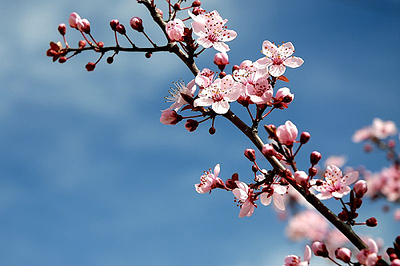
Spring’s Interlude
may winds whisper, soon summer’s arrival
in time to insure humor’s survival
winter’s rains held firm and quite long this year
but stubborn skies at last begin to clear
the seasons bow for this brief interlude
as if to hail my brightened attitude
seeds push eager sprouts through warm fertile earth
as nature cycles to this time of birth
buds pop boldly forth through ripe ready limb
new waters push fresh streams beyond their brim
bird songs sparkle crisp through tall greening trees
fragrance of new bloom wafts soft stirring breeze
all ’round the hues and sound of boisterous spring
quiet and sweet, my heart begins to sing
~ ~ ~
…and this time in the rhythm of iambic…
the wind sighs soon fair summer will arrive
to guarantee my humor will survive
the rains of winter held on long this year
but now the sky above’s becoming clear
the seasons bow to greet this interlude
as if to hail my brightened attitude
new seeds push eager sprouts up through warm earth
as nature cycles to this time of birth
bold buds pop forth through ripe and ready limb
fresh waters push clear streams beyond their brim
the songs of birds lilt crisp through greening trees
the fragrance of new blooms wafts soft the breeze
all ’round the hues and sound of boisterous spring
as pure and sweet my heart begins to sing
~ ~ ~
rob kistner © 2012
this is great rob….we had the opposite as far as the weather…spring came in like january…but i def understand how the weather, the season affects the mood…love the smell of blooms and birdsongs, nice touch on all the senses…
Very sensuous, Rob. I like the season’s bow… the streams, flowers and birds… my heart sings during spring, too.
Really love the visual and the good feeling in this one! Wonderful write! I love spring and summer, too, and you brought them to life!
http://charleslmashburn.wordpress.com/2012/05/03/then-quickly-gone/
Beautiful, I feel joy after reading your poem, it makes me look forwards to summer.
“just in time to insure humor’s survival”
Indeed.
I like the spring’s interlude ~
http://a-sweetlust.blogspot.ca/2012/05/road.html
This definitely describes my feeling about how this winter has taken its time to turn into spring, but how now as the buds lift and stems green, the heart too warms. Great expressionism, and a good example for a Clarian sonnet!
nice…i’m singing along with spring for sure..smiles
Love the words, the affinity with the season.
But I couldn’t find iambic pentameter anywhere. 10 syllables a line do not a sonnet make, nor counting them a rhythm!
Hi Viv — You know how I dislike traditional “formâ€, but as a lark, I was just following the prompt, as I understood it, for the “Clarian†Sonnet as found today at dVerse, which did not call for an ‘iambic’ rhythm, nor did the example of the John Clare piece represent a strict iambic pattern, as I interpreted it. I thought I understood this deviation from pure iambic to be one of the differentiations in the Clarian Sonnet, though perhaps I was wrong? To quote the particular dVerse post: “…a different structure from the more usual Shakespearian or Petrarchan forms. This type of sonnet has come to be known as a Clarian sonnet, and is composed of seven sequentially rhymed couplets – aa bb cc dd ee ff gg – in pentameter, or ten syllables per line…†Oh well… 🙂
Rob, you are a good and faithful sonneteer: I love the new version – it reads aloud so much better. Thanking you for easing my angst!
Viv… 😉
You can always make it iambic, if you like… but I’m not biased against trochees!
By the way, John Clare didn’t like punctuating his poems (check out the example). An interesting fellow.
Well done that man, with the second version in iambic pentameter and the poem has a lovely feel to it, flowing nicely through its message. Very impressive, Rob. Sonnets aren’t easy to write, particularly getting the rhythm, whether iambic or trochaic pentameter whilst conveying the message in joined up grammatical English. I think even Shakespeare deviated sometimes from perfect iambic scansion, so we can be forgiven for same. I’d sooner get the language right first then think about the scansion.
Love both poems too, Rob, and like
me you went back and tightened
up the first one to draw it closer
to the dVerse challenge; and like
mine, I prefer the tighter second
one; excellent effort here; good on you!
Actually, Samuel Peralta, the gentleman who posted the dVerse prompt wrote the following to me two comments prior to yours here Glenn; he wrote, “…You can always make it iambic, if you like… but I’m not biased against trochees! By the way, John Clare (also) didn’t like punctuating his poems…”
I do like the idea of rearranging the first poem in iambic, though I think the first read quite well as is. It’s a close race, but the first has bit more verve than the second, though I enjoyed it too.
Each is terrific; I personally liked the iambic better, for the flow.
I was all caught up in the sweet sense of spring in the first and then came upon the second one as a bonus, and wound up preferring the second while still loving the first!